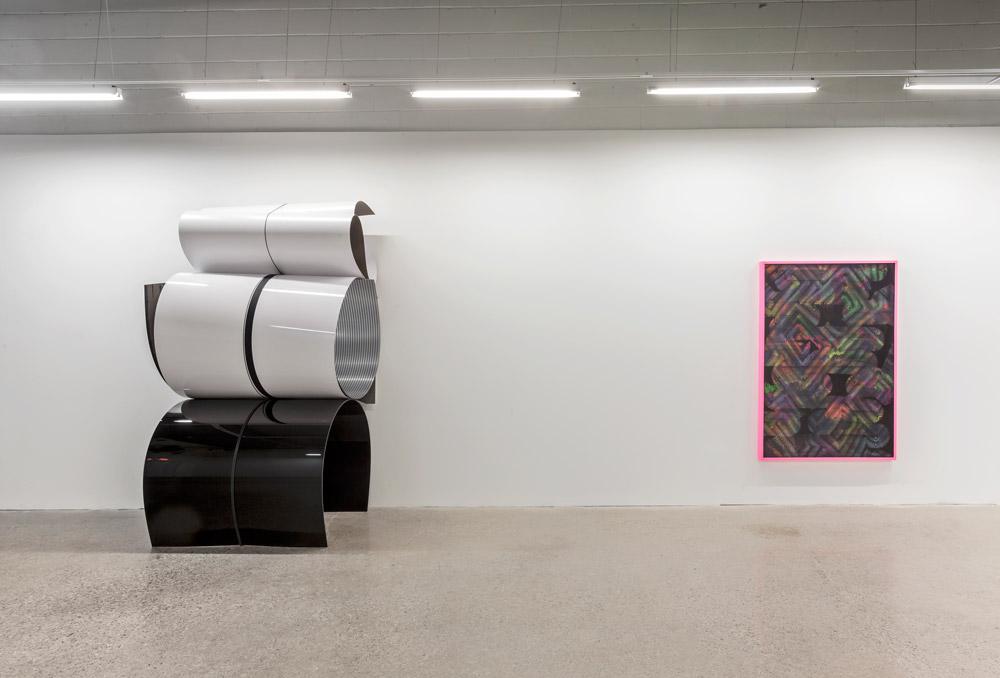Toronto-raised, Brooklyn-based artist Julia Dault has had quite a year. Since her critically acclaimed breakthrough last February in the New Museum Triennial, she has shown at the Gwangju Biennale, the Marrakech Biennale, and London’s White Cube.
On Friday, Dault’s first solo exhibition in Canada—consisting of two sculptures and seven paintings—opened at the Jessica Bradley Gallery Annex in Toronto.
Dault’s sculptures are largely what have won renown, and they are the main attraction here. Fashioned in situ out of Plexiglas, Formica, cotton cord and Everlast boxing wraps, their titles denote respective production timelines: this show, for instance, includes Untitled 26, 10:30 AM–2:30 PM January 22, 2013 and Untitled 27, 11:15 AM–2 PM, January 23, 2013.
The sculptures are appealing in many ways. Art-historically, the materials of Donald Judd’s angular, pre-planned, manufactured minimalism are diverted into circular, spontaneous, embodied and handmade environs of performance and live art. Visually, there’s a funhouse-mirror effect in the curved Plexi, and some similarly illusionist intrigue in the fact that the sculptures can be voluminous from one perspective and insubstantial (in fact, full of holes) from another. Overall, the sculptures manage to have a muscular quality while also being light and airy.
Dault’s paintings are generally less remarked upon, and they may operate for some viewers as souvenirs of, or pointers towards, her sculptural triumphs. The curve motifs in Dault’s sculptures often carry through to the surface patterns, which are generated by pushing combs or squeegees through paint. The layered quality of her sculptures is also present—one painting strata consists of acrylic on canvas under acrylic on vinyl under vinyl under acrylic on vinyl. These are wall works one can peer into, with a construction process and patterning that seem to test how much depth a single surface can have.
For me—a Canadian born in 1975, two years before Dault—pop culture of the 1980s and early 1990s is another factor binding the works in the exhibition, as is the resurgence of 1980s/1990s elements in present-day fashion, music and design trends. Painting titles such as Steel Magnolias, Snowbird, Moonwalk, and 2 Legit directly allude to the era. The prevalence of iridescent, pastel and neon hues, as well as plasticy, glossy textures, also evokes that moment. Together, these factors inject a cheesy, lighthearted (and, it must be said, somewhat fashionable) note into an abstract-art legacy steeped in seriousness.
Also for me personally, the legacy of the feminine and the feminist was another part of the connective tissue. I feel ashamed to admit this more essentialist reading, as I recognize that my mind generated associations for Dault’s works it likely wouldn’t have for similar works by a male artist. Among my chagrined wonderings was whether the stacked and curved shapes of Dault’s sculptures could be compared to an avant-garde high heel shoe, a bouffant hairdo, or even the Venus of Willendorf. The layered, textured-yet-finessed quality of these works also pinged my neurons vis a vis the aesthetics of contemporary nail art. On a more academic (and legitimate-seeming) note, the performative aspect of Dault’s sculptures, as well as their processes of stacking, folding and knotting, summoned some of the live-art traditions in feminist artmaking.
In the end, I am grateful to Dault’s exhibition for serving as an opportunity to think through these associations. On reflection, I remembered that male artist and critic Sholem Krishtalka recently did a nail-art-based performance, while designer Jeremy Laing has made a nail-art-based tapestry. (Perhaps, I might ask playfully, could nail art be the latest popular word in that everlasting saga between figuration and abstraction?) I wondered why I don’t view hairstyles, clothing and adornment as “legitimate” influences on artistic production. And I also remembered that in her paintings, Dault often layers scraps of factory-printed silk, polyester, linen and pleather—substances which needn’t choose between being feminine and industrial, but are easily both at the same time.









